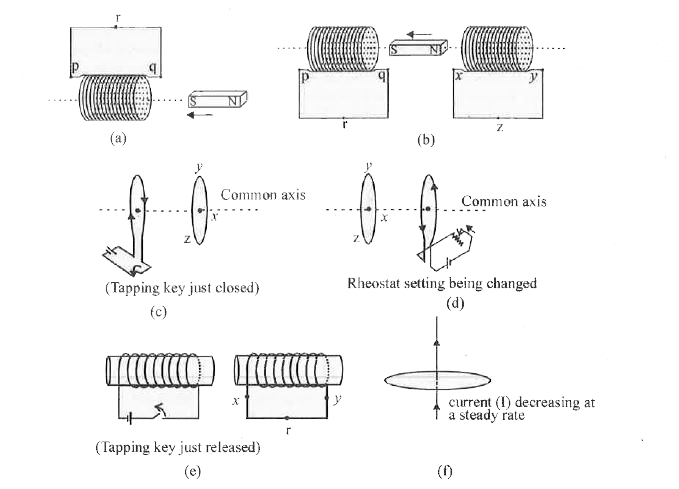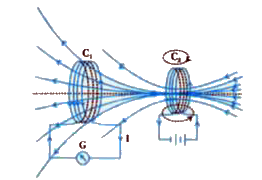Consider Experiment II in Section 6.2.
a. What would you do to obtain a large deflection of the galvanometer?
b. How would you demonstrate the presence of an induced current in the absence of a galvanometer? Solution in Tamil
a. To obtain a large deflection, one or more of the following steps can be taken:
(i) Use a rod made of soft iron inside the coil C2 (ii) Connect the coil to a powerful battery, and (iii) Move the arrangement rapidly towards the test coil C1.
b. Replace the galvanometer by a small bulb. The relative motion between the two coils will cause the bulb to glow and thus demonstrate the presence of an induced current.
Topper's Solved these Questions
- BOOK - NEW JOYTHI PUBLICATIONCHAPTER - ELECTROMAGNETIC INDUCTION EXERCISE - SOLUTIONS TO EXERCISES FROM NCERT TEXT14videos
ELECTROMAGNETIC INDUCTION
- BOOK - NEW JOYTHI PUBLICATIONCHAPTER - ELECTROMAGNETIC INDUCTION EXERCISE - PRACTICE PROBLEMS FOR SELF ASSESSMENT3videos
ELECTROMAGNETIC INDUCTION
- BOOK - NEW JOYTHI PUBLICATIONCHAPTER - ELECTRIC CHARGES AND FIELDS EXERCISE - Competitive Exam Corner20videos
ELECTRIC CHARGES AND FIELDS
- BOOK - NEW JOYTHI PUBLICATIONCHAPTER - ELECTROMAGNETIC WAVES EXERCISE - COMPETITIVE EXAM CORNER16videos
ELECTROMAGNETIC WAVES
Similar Questions
Predict the direction of induced current in the situations described by the following figures (a) to (f).
 03:06View Solution
03:06View SolutionA long solenoid with 15 turns per cm has a small loop area 2.0cm2 placed inside the solenoid normal to its axis. If the current carried by the solenoid changed steadiy from 2.0A to 4.0A in 0.1 s, what is the induced emf in the loop while the current is changing?
04:59View SolutionTwo charged spherical conductors of radii R1andR2 are connected by a wire. Then the ratio of surface charge densitites of the spheres σ1/σ2 is
01:16View SolutionIf the total electromagnetic energy falling on a surface is U, then the total momentum delivered (for complete absorption) is
02:57View SolutionConsider Experiment 2, Art. 4(a). 3, (a) What would you do to obtain a large deflection of the galvanometer ? (b) How would you demonstrate the presence of an induced current in the absence of a galvanmeter ?
02:45View SolutionConsider experiment 6.2 (a) What would you do to get more deflection in the dielectric? (b) How would you indicate the presence of an induced current in the absence of a thermometer?
02:53View SolutionWhat would you do to obtain a large deflection of the galvanometer?
View SolutionHow would you demonstrate the presence of an induced current in the absence of a gal-vanometer ?
View Solutionफैराडे एवं हेनरी के प्रयोग संख्या दो में विचार करके बताइए -
धारामापी की अनुपस्थिति में आप प्रेरित धारा की उपस्थिति किस प्रकार दर्शाएँगे ?03:23View SolutionConsider Experiment 6.2. (a) What would you do to obtain a large deflection of the galvanometer? (b) How would you demonstrate the presence of an induced current in the absence of a galvanometer?
04:44View SolutionConsider Experiment 6.2. (a) What would you do to obtain a large deflection of the galvanometer? (b) How would you demonstrate the presence of an induced current in the absence of a galvanometer?
04:56View SolutionConsider Experiment 6.2. (a) What would you do to obtain a large deflection of the galvanometer? (b) How would you demonstrate the presence of an induced current in the absence of a galvanometer?
04:44View SolutionConsider Experiment II in Section 6.2.
a. What would you do to obtain a large deflection of the galvanometer?
b. How would you demonstrate the presence of an induced current in the absence of a galvanometer?01:42View Solution
Consider Experiment:
(a) What would you do to obtain a large deflection of the galvanometer ?
(b) How would you demonstrate the presence of an induced current in the absence of a galvanometer ?01:13View SolutionConsider Experiment 2, Art. 4(a). 3,
(a) What would you do to obtain a large deflection of the galvanometer ?
(b) How would you demonstrate the presence of an induced current in the absence of a galvanmeter ?04:19View Solution

